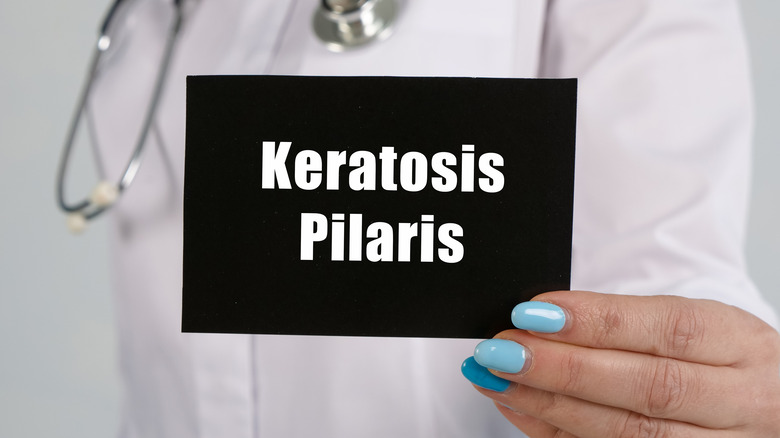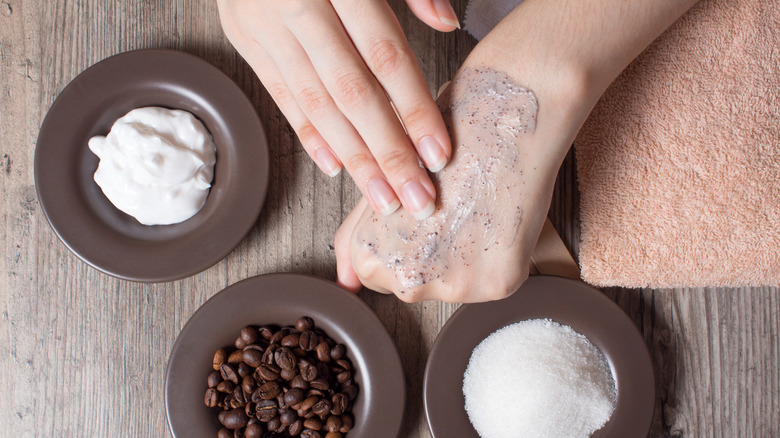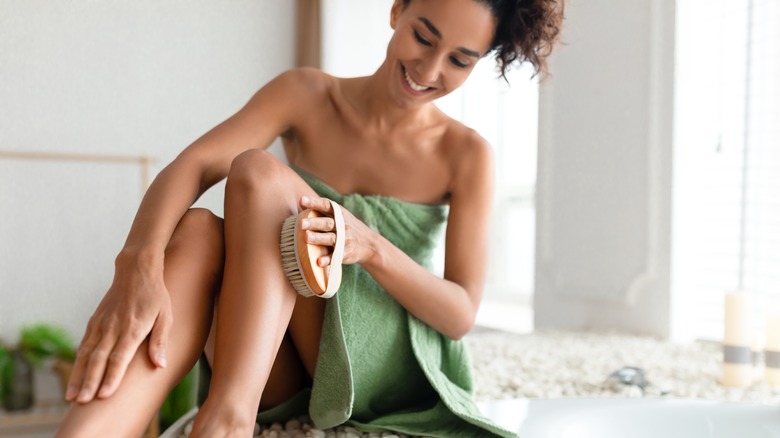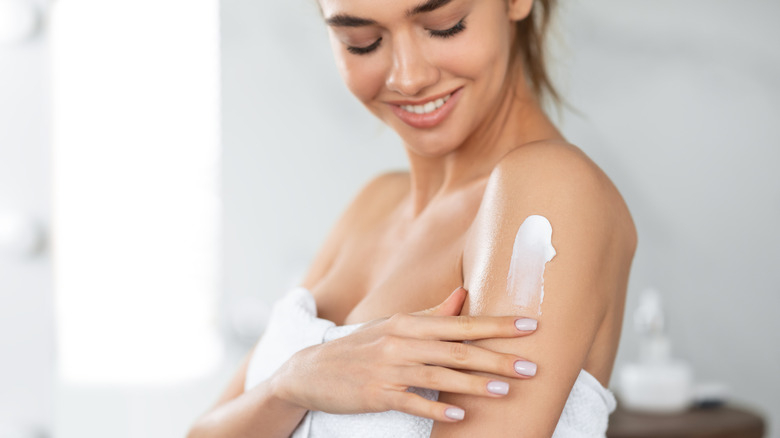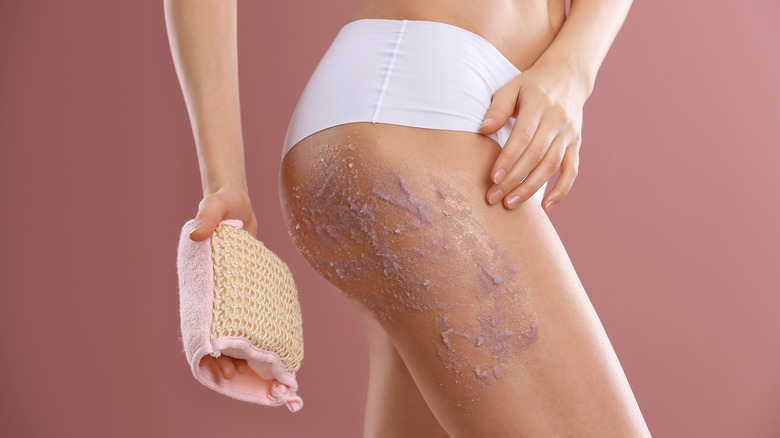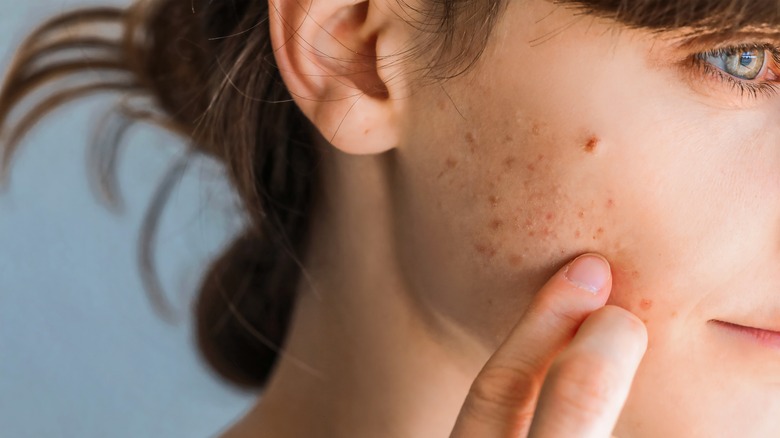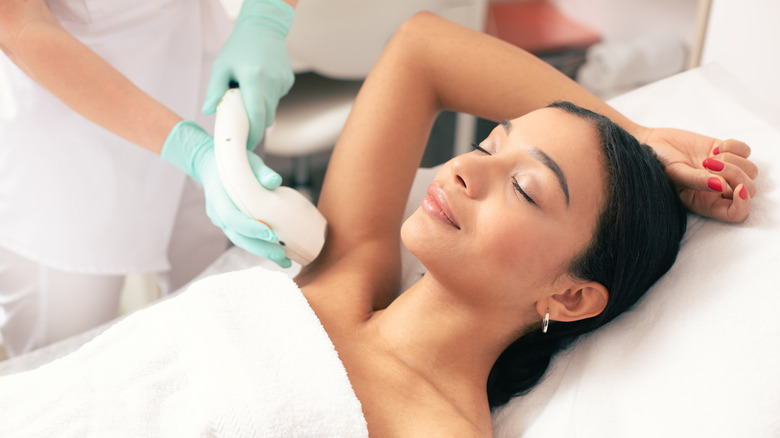10 Tricks For Getting Rid Of Keratosis Pilaris On Your Arms And Legs
We may receive a commission on purchases made from links.
Of all the various skin conditions that exist, keratosis pilaris is probably one of the most frustrating. This harmless, mostly painless skin condition can leave many feeling like they want to wrap themselves in a trash bag and make their way through the world without anybody getting a peek at their red, bumpy skin. While this condition often isn't as visible to outsiders as the person who has it, it can really make some people feel incredibly self-conscious, especially during the summer months when everyone's showing more skin.
Women are more prone to keratosis pilaris (why is it always us, ladies?), and it's more common in children and people under the age of 50. It is primarily caused by an excess production of keratin and dead skin cells that end up blocking hair follicles, Sarah Villafranco, M.D., explained to MindBodyGreen. This results in enlarged follicles, which often become irritated and inflamed. Board-certified dermatologist Melissa Kanchanapoomi Levin told Marie Claire that keratosis pilaris is often genetic. While some people outgrow it, there is no way to get rid of it for good. You can treat keratosis pilaris, but you need to do so continuously. Otherwise, the bumps return in all their glory for the next round.
Various treatments exist for this pesky skin condition, some more effective than others, and while you can't remove it entirely, we put together 10 tricks for getting rid of keratosis pilaris on your arms and legs that will hopefully help your skin reclaim its glow.
Regularly exfoliating can help keratosis pilaris
If you have keratosis pilaris, exfoliation is the first step to better skin because it does a great job of removing the build-up of dead skin cells, according to the American Academy of Dermatology. If you've tried exfoliation before and your skin seemed worse after, it might simply be because you didn't do it the right way. Rachel Nazarian, M.D., a dermatologist from New York City, told Vogue that most people try to literally scrub the bumps off their skin. While it's natural to want to get rid of those bumps ASAP, scrubbing your skin with a rough loofah will actually make things worse.
"Although this technique will work temporarily by dislodging the keratin plugs, rough exfoliation will inflame the skin and hair more, ultimately causing increasing redness and making the condition even more noticeable," Nazarian says. That is, of course, the last thing you want. Nazarian advises you to opt for exfoliators that are specifically formulated to treat keratosis pilaris, like the First Aid Beauty KP Bump Eraser.
Chemical exfoliators are often recommended by experts because they dissolve dead skin cells, something that's vital in treating keratosis pilaris. Blair Murphy-Rose, M.D., F.A.A.D., says that chemical exfoliators usually contain AHAs (glycolic acid and lactic acid) and BHAs (salicylic acid) as well as a PHA (gluconolactone), and urea. If you have the means, you can also go for stronger in-office chemical peels, which are usually done bi-weekly or monthly.
Use retinoids to unclog hair follicles
Retinoids have been praised for their efficacy in treating a variety of skin conditions, including fine lines, wrinkles, and even acne. Even though retinoids are commonly used for facial skin care, they can work just as well for keratosis pilaris on your arms and legs, according to dermatologists.
Melissa Kanchanapoomi Levin, a board-certified dermatologist, told Marie Claire that retinoids are effective because they speed up the rate at which your skin cells renew, which means it prevents dead skin cells and keratin buildup. Levin says that AHAs and BHAs are still considered the most effective treatment for keratosis pilaris, but for those who find that those treatments don't yield results, retinoids might be the answer. However, they are usually more expensive, especially if you apply them to your entire body. You might want to test out generic retinol creams first and see if your skin tolerates them before opting for more expensive products.
Prescription retinoids are also an option, but dermatologist Noelani González told the Strategist that Differin, which is available over the counter, is an extremely effective retinoid that can help treat keratosis pilaris as well as other skin conditions like scarring, acne, and discoloration.
Try dry brushing
You might have heard of dry brushing before; it became a bit of a trend a few years back, and many touted it as a miracle cure for various skin conditions, ranging from cellulite to keratosis pilaris. While dermatologists say it definitely doesn't do anything to remove cellulite, dry brushing can be effective for treating keratosis pilaris.
If you've never heard of dry brushing, fear not, it's fairly simple. It basically refers to brushing your skin with a long-bristled brush. Dermatologist Stacy Chimento told Greatist that dry brushing tends to work well to get rid of dead skin cells. It's pretty much a gentle form of exfoliation without applying any extra products, and it helps to promote blood flow.
"Theoretically, the exfoliation of dry brushing could help improve keratosis pilaris," Chimento said. Now, before you rush to the store to get the perfect brush to kickstart your dry brushing ritual, Chimento warns that the same rules of exfoliation apply to dry brushing. Don't overdo it, and take care to apply gentle pressure. After all, rough exfoliation will only make keratosis pilaris worse.
Make sure you moisturize your skin properly
Dermatologists agree that those who have keratosis pilaris need to follow their skincare regimen religiously. Exfoliation and moisturization are the most important, and it needs to be done regularly in order to see and maintain results. "The continuous use of the creams will help smooth skin, followed by the eventual fading of the surrounding redness, but once treatment is discontinued the bumps reappear," Rachel Nazarian, M.D. told Vogue. She added that keratosis pilaris especially tend to flare up when the weather gets colder and drier, so patients should pay close attention to their moisturizing regimen when fall and winter arrive.
Blair Murphy-Rose, M.D., F.A.A.D., says to opt for moisturizers that contain a combination of emollient, humectant, and occlusive ingredients. "Look for ingredients like ceramides, shea butter, petrolatum, dimethicone, glycerin, and hyaluronic acid," Murphy advises. You can also add in some extra ingredients like aloe and niacinamide, which have anti-inflammatory properties that can help clear redness.
Murphy advises you to opt for products that are an exfoliator and moisturizer in one. This makes it easier to stick to your skincare regimen and keep those pesky bumps at bay. The most important thing is that you keep treatment consistent. "I remind my patients not to get discouraged — many people outgrow the condition and it typically lessens as they get older," Nazarian adds. So, there is a light at the end of the tunnel, but while you are waiting to approach it, remember to moisturize!
Use gentle skincare products
If you have keratosis pilaris, you need to stay away from harsh skin care products. Anjali Mahto, a dermatologist at Skin55, told Elle that gentle body washes and soaps are the way to go. We all love a foamy, amazing-smelling body wash, but keratosis pilaris, unfortunately, does not. Bland is the way to go, with body washes that are fragrance-free and contain emollients. These products might not look or smell fancy, but Mahto says that they'll make your skin feel smoother and moisturized. A great product that ticks all the boxes is Cetaphil's milky cleanser. It's fragrance-free and doesn't contain any comedogenic (pore-clogging) ingredients, which means you'll get all the moisture without added bumps. Sweet.
After showering or bathing, you should apply a gentle but effective moisturizer. If you're a fan of applying body oil after washing, you might want to switch to a moisturizer that contains humectants and exfoliators so you can hit two birds with one stone. Look for lotions that include AHAs and BHAs as well as urea. The latter will ensure your skin locks in moisture. Dermatologist Justine Kluk advises that you apply your moisturizer in a downward direction to damp skin to fully utilize the ingredients in your products. E45's Dermatological Cream Treatment will do the trick here. Thank us later.
Use products designed to get rid of dead skin cells
If you have keratosis pilaris, keratolytics are about to become your best skin friends. A more common name for keratolytics is a chemical exfoliator, and its main job is to remove dead skin cell buildup, which, in turn, leads to smoother skin.
Compounds like salicylic acid, urea, and lactic acid are all considered keratolytics and can help ease keratosis pilaris if used correctly, according to Verywell Health. Salicylic acid basically works like an exfoliant; it breaks down connections between dead skin cells, helping your skin to get rid of them so there's less buildup. Thanks to its exfoliating properties, salicylic acid also helps the skin absorb products better. Urea also aids the skin in absorbing products and serves as a moisturizer. It can also help calm itching. Lactic acid, on the other hand, is actually a compound produced by our bodies, and it can work wonders for keratosis pilaris thanks to its exfoliating and skin-renewing properties. As an extra bonus, it can also help hydrate the skin, but you need to be extra careful of sun exposure if you use this compound in your skincare routine.
Even though keratolytics are effective, it would be wise to speak to a dermatologist about how to correctly apply these products so you don't end up irritating your skin even more.
Don't pick your skin
If you have keratosis pilaris, chances are you've had the urge to pick at those bumps. If you gave in to the urge, you probably regretted it later. Picking is one thing you want to steer clear of, dermatologist and psychiatrist Amy Wechsler, M.D., told Self. She said that many people initially think their keratosis pilaris is acne, and then proceed to treat it as such, which only makes it worse. Others pick at it with the hope of getting rid of it or scrubbing it vigorously. The result is the same: unhappy skin.
Some people know that they have keratosis pilaris and that they shouldn't pick at it, but simply can't help themselves. Wechsler suggests that people who struggle to stop picking their skin find something else to keep their hands busy, like a Rubix cube, a scrunchy, or a rubber band. If possible, wearing long sleeves can also help you to minimize picking.
In an article that licensed professional counselor Trudi Griffin wrote for the Skinpick blog, she explains that being unable to control skin picking often means that someone has compulsive picking disorder, also known as dermatillomania. She warns that picking at keratosis pilaris can not only make your skin look worse but can also leave some nasty scars. Her advice echoes Wechsler's – keep your hands busy with something else like a stress device, and, if all else fails, put on gloves so you literally can't pick at your skin.
You could try laser treatments
Laser treatments are used to treat various skin conditions, and luckily, they can help treat keratosis pilaris as well.
While not much can be done for the bumps (yes, that sucks), laser treatments can effectively treat redness, dermatologist Anjali Mahto told Elle. She recommends light and laser treatments like IPL and pulsed dye. If you have any skin discoloration or pigmentation due to keratosis pilaris, laser treatments can help clear those too, dermatologist Justine Kluk says.
A 2000 study published in the Journal of Cutaneous Laser Therapy found that pulsed tunable dye laser treatments are very effective at reducing the redness associated with keratosis pilaris. It also found that this laser treatment can help reduce skin roughness.
Furthermore, dermatologist Mary Thomas told Cosmpolitan that pulsed dye laser treatment typically requires three to six treatments to be effective, and you'll have to dish out around $400 for each. To treat skin roughness, however, she recommends patients opt for laser hair removal treatments. Although it's not been proven yet, dermatologists suspect that hair trapped in follicles is part of what causes those infamous keratosis pilaris bumps. This means that completely removing the hair would prevent that from happening and, in turn, promote smoother skin. The price of this treatment varies depending on where you go to get it as well as the part of your body you'd like treated, but Thomas says you can expect to spend at least $300 per appointment. You'll typically need four to six treatments.
Try to opt for anti-inflammatory foods
If your gut health is out of whack, it can manifest in various ways, and if you already suffer from keratosis pilaris, you might notice that an unhappy gut contributes to even unhappier skin, per MindBodyGreen.
Keratosis Pilaris can get worse if your body is already experiencing inflammation, so making sure you eat unprocessed whole foods most of the time can go a long way. Foods rich in antioxidants can also help the body fight off inflammation.
Holistic dermatologist Alan Dattner, M.D., told MindBodyGreen that he usually encourages patients with keratosis pilaris to up their vitamin D and A intake because these vitamins work to promote the growth of healthy skin cells. He added that conditions like leaky gut could also make keratosis pilaris worse because it causes inflammation. Giving your gut microbiome a boost with probiotics and digestive enzymes could help. Of course, you should never diagnose yourself with such a condition and speak with your doctor if you suspect you might suffer from gastrointestinal issues like leaky gut.
In an article that licensed professional counselor Trudi Griffin wrote for Skinpick, she advises that people try to treat their keratosis pilaris by eating foods rich in vitamins C, E, K, and B. These vitamins all work to strengthen and heal the skin while protecting it from inflammation. Vitamin B can also be very beneficial when you experience a lot of itching, whereas vitamin K can work wonders for sensitive skin during treatments.
Avoid hot baths and showers
While you might think there's nothing more relaxing than a long, hot bath, your keratosis pilaris disagrees. Hot water strips the skin of moisture, which is the last thing you want when trying to treat this skin condition.
Dermatologist Lisa Airan, M.D., and physician Sarah Villafranco, M.D., told MindBodyGreen that those who suffer from keratosis pilaris need to steer clear of spending too much time in hot water. This doesn't mean that you suddenly need to take cold showers and baths (that would be absolutely terrible), but you should go easy on the hot water faucet. There's hot water and there's super hot water – opt for the former, and don't spend too much time soaking in it. According to the Dermatology Associates of Virginia, a five to 10-minute shower or bath is best. Anything longer than that will compromise your skin's moisture levels.
Blair Murphy-Rose, M.D., F.A.A.D., told Vogue that it's important to apply moisturizer immediately after taking a bath or shower. She recommends you use your towel to pat your skin dry but leave it a little damp so you don't apply the moisturizer to completely dry your skin. This helps your skin to stay hydrated.
